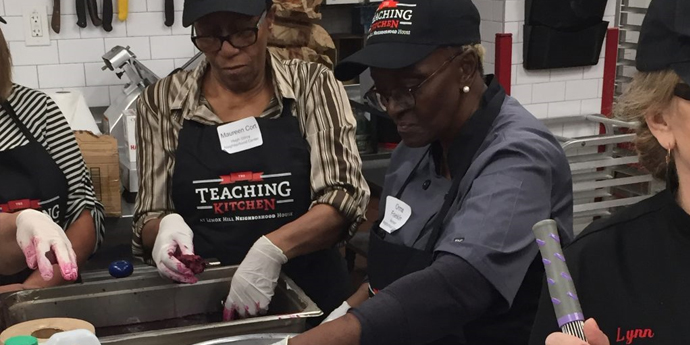Progress Areas
Enhancing Impact

Goal
Leverage our resources to increase impact
Progress
- Leveraged nearly $47 million from public and private sources, including direct co-funding and money raised.
What this means
Leveraging is a strategy across all program areas. Since 2009, approximately $522 million has been leveraged.
Leveraging has allowed us to support efforts in specific regions of the State, to help sustain those efforts, and to expand them across the State.
Enhancing Impact

Goal
Deploy activist model to achieve broad policy impact
Progress
- Organized an activist campaign to ensure Veterans Treatment Courts are available to all veterans in New York State.
- Spearheaded efforts to ensure that low-income residents in New York State and across the nation have continued access to Supplemental Nutrition Assistance Program (SNAP) benefits at farmers markets.
- Responded to a range of requests for public comments on issues relating to health care coverage, price transparency, the federal “public charge” proposed rule, and the Medicaid Diabetes Prevention Program.
- Participated in coalitions geared toward promoting activist agendas by the philanthropic community.
What this means
We are continuing efforts to be not just a grantmaker, but also a changemaker.
Using our reputational and human capital enhances our impact beyond grantmaking.
Participating in public comment processes is a way to inform and influence policy. We plan to be active contributors of such policy documents.
Building Healthy Communities

Goal
Promote community cohesion, organizational capacity, and sustainability
Progress
- Established new public/private partnerships to extend and deepen our place-based investments, including with the Syracuse Housing Authority, Niagara Falls Community Development, and the NYC Mayor’s Office of Criminal Justice.
- Identified and began working with a new Community Convener, University Settlement Society of New York, on the Lower East Side.
- Continued work by our grantees to amplify community cohesion activities that engaged residents and showcased improvements being made in the neighborhood.
- Documented current progress and disseminated lessons learned through our interim assessment report.
- Expanded the formal evaluation of this initiative to include assessing community cohesion, organizational capacity, public safety, and sustainability.
What this means
Success requires a broad range of players that go beyond health and other typical stakeholders.
Our approaches are flexible and adaptable to changing circumstances on the ground.
These collaborative arrangements will help secure organizational capacity and sustainability.
Learnings have been used to shape our grantmaking and evaluation approach and broadly shared to inform the field.
Building Healthy Communities

Goal
Improve access to safe places where residents can be more physically active
Progress
- Improved activation of approximately 50 parks and public spaces in the first three years, with 15 spaces in 2018 alone, including renovating and activating underused spaces.
- Adjusted our grantmaking to address public safety, including a resident safety initiative to support enhanced use of public spaces.
What this means
While the total number of neighborhood parks, recreation facilities, or open spaces has remained steady, there has been more investment in improving parks and playgrounds and engaging residents in the design process.
Ensuring public safety is a prerequisite to physical activity. We will be studying the impact of our public safety efforts in the coming year.
Building Healthy Communities

Goal
Improve access to and demand for nutritious foods
Progress
- Created 25 new access points to healthier food across all neighborhoods in the first three years. In 2018, 53 new access points were created through a range of efforts by NYHealth and others, including through Clinton County’s Better Choice Retailer Program, food stores stocking a healthier selection of foods, and new farmers markets, youth markets, and urban farms.
- Supported expansion of innovative nutrition incentive programs, educated food producers and consumers, and advanced nutrition education and healthy food procurement in schools and other institutions to increase demand for healthier food across New York State.
What this means
All neighborhoods have created more access points to healthy food. Progress has not been as fast as we hoped, though, because of the need to address barriers such as affordability and resident demand.
Empowering Health Care Consumers

Goal
Ensure greater transparency of and access to price, quality, and patient experience information
Progress
- Invested in new transparency tools and resources to better arm New Yorkers with health care information:
- Launched the ExpectNY website, where expectant parents can look up various quality metrics by hospital.
- Released the NYPlanCosts Calculator, where consumers can compare out-of-pocket costs for various chronic conditions by health plan.
- Developed the Healthcare Transparency website, a first-of-its- kind searchable comprehensive database of 230 public transparency tools.
- Supported the “Difficult Decisions” report series, which identifies promising approaches so that patients and caregivers can better assess post-acute care setting options.
- Developed the “Connecting Consumers to Information” initiative, with support to two statewide primary care provider associations (NYSAFP and NYACP) and technical assistance to engage clinical and nonclinical staff at medical practices to connect patients to available health care transparency tools and resources.
- Supported implementation of OpenNotes at 10 hospital systems to make doctors’ clinic notes accessible and actionable for patients.
- Invested in a statewide quality transparency survey that will gather New Yorkers’ perspectives on the type of health care quality measures that matter to them.
What this means
We continue to make information transparency tools more available to New Yorkers.
While funding transparency tools, we are also highlighting best practices and exemplar tools.
Because simply creating tools is not enough, we are targeting providers—who are a trusted source of information—as conduits for educating patients about tools at the point of care.
The number of patients who now have access to their notes has grown. However, full implementation of OpenNotes has been challenged by provider resistance, inflexibility of some electronic health record systems, and concerns over accessing pediatric, oncology, and mental health notes.
We have expanded beyond an initial focus on price information with broader attention on quality.
Empowering Health Care Consumers

Goal
Ensure that patients are partners in the clinical care delivery experience
Progress
- Published the first-of-its-kind study on the prevalence and role of Patient and Family Advisory Councils (PFACs) at hospitals in New York State.
- Supported a more nimble, adaptable, and deployable model for PFACs across New York State to ensure a wider array of patient voice representation.
- Supported a cohort of 12 hospitals across New York State with intensive technical assistance to enhance their patient and family engagement and person-centered care practices.
- Began collecting ideas directly from patients that can then be used to inform practice improvements and care delivery innovations.
What this means
Meaningful patient-engagement policies minimize patient burdens and create more accountability for the health care system to treat patients as partners in the health care experience.
More work is needed to increase the number of PFACs and to ensure that they are used to influence how care is delivered and how patients’ needs are met.
Empowering Health Care Consumers

Goal
Ensure that patients are partners in informing care delivery and health policies
Progress
- Sought changes in New York’s Certificate of Need process so consumers can inform decisions that affect access to care. Recommendations have gained traction with policymakers.
- Began training New Yorkers, especially in marginalized communities, to participate in community actions, advocate for policy change on critical health issues, and communicate their stories, needs, and policy priorities.
- Began building patients’ capacity to drive change and leveraging a digital organizing strategy to enlist New Yorkers in sharing their experiences, all with the goal of amplifying patient voices to shape and achieve policy objectives.
What this means
Consumers need a lasting and meaningful seat at the table. In 2018, we expanded our work to help New Yorkers drive and inform decisions that affect health care policy, quality, access, and costs in New York State.
We are also exploring innovative ways to better engage, train, and develop under-represented patient champions.
Improving Veterans’ Health

Goal
Increase visibility of veterans’ health issues
Progress
- Organized and/or participated in numerous events related to veterans’ issues, including:
- New York State’s first comprehensive veterans’ health conference focused on the emerging needs of minority and justice-involved veterans.
- Public “Conversation With” events with key veterans advocates, discussing gender disparities in the military and the impact on health, the health needs of the military community, and challenges faced by the broader military community.
- Roundtable discussions with New York City’s Department of Veterans’ Services on holistic care and with the Bronx VA on a potential public-private partnership to increase veterans’ access to mental health providers.
- Participated in 13 events sponsored by other funders, as well as local and national veterans advocacy organizations, including:
- Grantmakers in Health
- The Council on Foundations
- The Veterans Mental Health Coalition
- The National Organization of Veteran-Serving Organizations.
What this means
In addition to grantmaking, NYHealth uses leadership and leverage to advance our work to improve veterans’ health.
We have continued to forge new connections within the veterans’ health advocacy community, and are collaborating with veteran-focused funders on issues like improving access to Veterans Treatment Courts.
Improving Veterans’ Health

Goal
Increase access to comprehensive community-based services for veterans and their families
Progress
- Improved access to mental health care for post-9/11 veterans by expanding the Headstrong Project provider network to rural and suburban areas across New York State.
- Funded a study to investigate community-based providers’ readiness to provide culturally competent care to returning veterans in non-VA settings. The study found that only 2% of private providers in New York State fully meet the readiness criteria.
- Invested in improving the quality of care for returning veterans across New York State, including student veterans on SUNY campuses, incarcerated veterans held on Rikers Island, and veterans who seek care in private settings throughout New York City.
What this means
These grants have helped spread high-quality, community-based services to veterans in high-need areas across the State.
The study’s findings illuminate an important gap in providers’ readiness to care for New York’s veterans. We have shared the findings with valued stakeholders and focused on investing in organizations that can address this need.
Facilitating collaborations across various groups and navigating government bureaucracies can be challenging. We continue to leverage our networks to foster vibrant and successful partnerships with organizations throughout the State.
Special Projects Fund

Goal
Supporting new endeavors and organizations
Progress
284 letters of inquiry received:
- Nearly half of Special Projects Fund grants awarded in 2018 were to new grantees not previously funded by NYHealth.
What this means
The Special Projects Fund continues to keep the door open to work with a wider variety of grantees. This expands our audience and maintains a culture of openness to new players and ideas.
Special Projects Fund

Goal
Being responsive to emerging trends
Progress
- In 2018, Special Projects Fund grants addressed a wide range of topics, including gun violence and lead contamination in New York City’s water fountains and soil.
- Supported an analysis of a single-payer health care system for New York State. The analysis estimated the potential economic impact for New York residents, the State government, and employers. It garnered substantial attention, was cited in the debate between Democratic primary candidates in the New York Gubernatorial race, and has sparked conversations about options to achieve universal health insurance coverage in the State.
- Addressed the opioid epidemic by funding a pilot training toolkit for OB/GYNs on best practices for treating pregnant women and infants who are addicted to opioids.
What this means
The program balances our strategic grantmaking directed at specific priorities with grantmaking that is responsive to time-sensitive and emerging issues.
The Special Projects Fund allows the Foundation to contribute to the analysis of issues that require a non-partisan and independent voice that can inform policy discussions.
We are able to leverage lessons learned from prior projects, such as those addressing the opioid epidemic, to share best practices with interested stakeholders, policymakers, and funders.
Policy and Research

Goal
Conceive and generate original research informing health policy issues in New York State
Progress
- Produced analyses on pressing issues in New York State, including:
- A data brief on the six neighborhoods in our Building Healthy Communities program and the need for local approaches to improve health.
- A report on the association between doctors’ financial relationships with opioid manufacturers and opioid prescribing in New York State.
- A fact sheet on potentially toxic chemicals in personal care products.
- A data analysis noting various reasons for life expectancy decreases in New York State.
- An issue brief assessing a New York State initiative to increase locally-grown and produced food in schools.
- Published peer-reviewed journal publications on ensuring appropriate levels of reimbursement for the Medicare Diabetes Prevention Program and a national analysis of the potential conflicts of interest from physician relationships with opioid manufacturers.
- Published a blog post on lessons learned from our approach to developing a public-facing progress report.
What this means
These analyses complement our external grantmaking activities and support the Foundation’s agenda to inform health policy issues facing New Yorkers.
The range of topics allows us to enhance the work of our grant-making as well as to provide input on issues outside of our current program priority areas. Future work will place additional emphasis on alignment with the Foundation’s programmatic priorities.
Our work to date has helped expand the Foundation’s reach to a wide network of stakeholders for a wide array of issues. For example, the opioid research has informed investigational research by media, as well as lawsuits against opioid manufacturers in relation to the opioid epidemic in other states.
Communicating Effectively

Goal
Increase the visibility, credibility, and influence of the Foundation and its grantees
Progress
Publishing
- Published 27 reports and 19 commentaries, in addition to 18 grant outcome reports.
- Published 8 op-eds and letters to the editor.
Traditional Media
- Received 179 media hits.
E-mail/Social Media
- Maintained more than 12k contacts on our e-mail lists.
- Averaged 25% open rate for e-mail blasts (industry standard is 20%).
- More than 6k Twitter followers.
Convening
- Held 38 convenings; highlights include:
- Large external conferences in each of the Foundation’s focused priority areas: Consumer Empowerment, Building Healthy Communities, and Veterans’ Health.
- Engaged hundreds of participants through webinar briefings on the NYHealth-funded analysis of a single-payer health care system in New York State.
Website
- Continued to refine the website to support publications that are less text-heavy, more digestible, and more shareable and interactive.
- Began experimenting with dynamic infographics on website and social media to increase engagement.
What this means
A robust and proactive communications program is a fundamental part of the Foundation’s operating model.
Communications shape the visibility, reputation, influence, and impact of the Foundation and the work supported through our grantmaking.
Communications metrics reflect growing profile within New York State and nationally.
We continue to use technology—including Facebook Live and webinars—to engage our audience virtually.
Investing & Operating Effectively

Goal
Strong endowment/ investment performance
Progress
- As of December 31, 2018, the 3-year compound annual return on endowment investments was 5.5%, net of fees. This reflects the sharp decline in stocks during the fourth quarter of 2018, which produced a 6.3% loss for the year.
- Investment performance relative to peers for the 3-year period ending September 30, 2018 ranked in the 89th percentile.1
- Maintained return of 5.6% since inception (July 2006).
- When compared with the benchmark of 5% plus CPI (Consumer Price Index) since inception, NYHealth was 1.1% below the benchmark.
1 Peer data is based on a survey conducted by Cambridge Associates; “peers” are defined as foundations with less than $500 million in assets. There are currently more than 52 foundations contributing such data.
What this means
The value of our endowment in 2006 was $265 million. Since then, investment return has been in the top quintile of peer group, allowing the Foundation to spend $186.2 million on grants and operations.
The Foundation is carefully monitoring warning signs of continued volatility in investment markets.
Investing & Operating Effectively

Goal
Strong internal management and customer service
Progress
- For 2017, NYHealth was certified with another clean audit.
- The average rating by grantees of NYHealth staff members’ responsiveness was 6.4 (out of a 7-point scale), putting NYHealth in the 61st percentile relative to peer foundations.2
- In 2018, all grantees received their initial payment within an average of 10 days of receiving an award notice.
2 Based on the 2017 Center for Effective Philanthropy Grantee Perception Survey.
What this means
Receiving a clean audit each year reflects our commitment to operational efficiency and transparency.
Our goal is to continue to improve upon our customer service to grantees.
Providing timely funding is especially important for smaller organizations working on time-sensitive issues.


